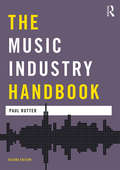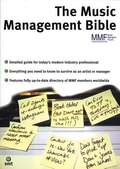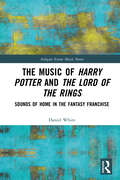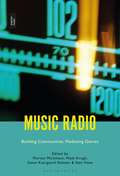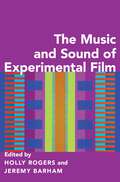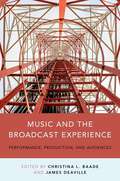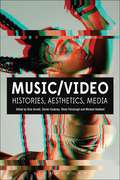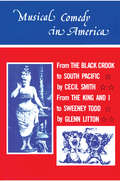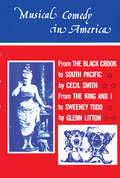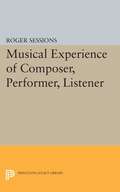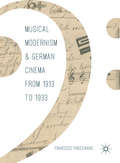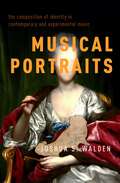- Table View
- List View
The Music Industry Handbook (Media Practice)
by Paul RutterThe Music Industry Handbook, Second edition is an expert resource and guide for all those seeking an authoritative and user-friendly overview of the music industry today. The new edition includes coverage of the latest developments in music streaming, including new business models created by the streaming service sector. There is also expanded exploration of the music industry in different regions of the UK and in other areas of Europe, and coverage of new debates within the music industry, including the impact of copyright extensions on the UK music industry and the business protocols involved when music is used in film and advertising. The Music Industry Handbook, Second edition also includes: in-depth explorations of different elements of the music industry, including the live music sector, the recording industry and the classical music business analysis of business practices across all areas of the industry, including publishing, synchronisation and trading in the music industry profiles presenting interviews with key figures workings in the music industry detailed further reading for each chapter and a glossary of essential music industry terms.
The Music Industry Handbook (Media Practice)
by Paul RutterThe Music Industry Handbook, Second edition is an expert resource and guide for all those seeking an authoritative and user-friendly overview of the music industry today. The new edition includes coverage of the latest developments in music streaming, including new business models created by the streaming service sector. There is also expanded exploration of the music industry in different regions of the UK and in other areas of Europe, and coverage of new debates within the music industry, including the impact of copyright extensions on the UK music industry and the business protocols involved when music is used in film and advertising. The Music Industry Handbook, Second edition also includes: in-depth explorations of different elements of the music industry, including the live music sector, the recording industry and the classical music business analysis of business practices across all areas of the industry, including publishing, synchronisation and trading in the music industry profiles presenting interviews with key figures workings in the music industry detailed further reading for each chapter and a glossary of essential music industry terms.
The Music Management Bible: (pdf)
by Music Manager'S Forum(Music Sales America). Detailed guide for today's modern industry professional. Everything you need to know to survive as an artist or manager, featuring fully up-to-date directory of MMF members worldwide. Today, the music business is bigger and more complicated than it's ever been. Wave after wave of Next Big Things are breaking on the ears of the fickle public, and with them is rising a whole breed of industry professionals implementing new systems to manage their stars. It's a dog-eat-dog world out there, and only the most business-savvy will survive. Thankfully, help is at hand in the form of The Music Management Bible . Written by seasoned experts in the business and produced in association with the Music Managers' Forum, here at last is a guide that will steer both artist and manager through the turbulent seas of music management, lifting the veil on such matters as publishing and recording contracts, merchandising, mediation and PR. With a complete list of affiliated managers and their acts, The Music Management Bible is an indispensable handbook for any aspirant to business.
The Music Never Stops: What Putting on 10,000 Shows Has Taught Me About Life, Liberty, and the Pursuit of Magic
by Peter ShapiroThe engrossing, insightful, and personal musical odyssey of Peter Shapiro, perhaps the most notable independent concert promoter since Bill Graham Peter Shapiro is the best known and most influential concert promoter of his generation. He owned the legendary Wetlands in Tribeca and has gone on to much bigger things, including Brooklyn Bowl (NYC, Las Vegas, Philadelphia, and Nashville), the Capitol Theatre in Port Chester, producing U2 3D, and promoting the Grateful Dead&’s fiftieth-anniversary tour (&“Fare Thee Well&”) featuring the Core Four and Trey Anastasio . . . and so much more. In The Music Never Stops, Shapiro shares the inside story of how he became a power-house in the music industry—an island in an increasingly consolidated landscape of venues, ticketing, and touring—through the lens of fifty iconic concerts. Along the way, readers gain insight into what it was like to work with some of the most celebrated bands in modern music, including not just the Grateful Dead and U2, but also Bob Dylan, Phish, Dave Matthews Band, Al Green, Ms. Lauryn Hill, Jason Isbell, Preservation Hall Jazz Band, The Roots, Robert Plant, Leonard Cohen, and many more. Featuring never-before-published back-stage anecdotes, insights, and photographs of the biggest bands in the business and the concerts that later became legendary, The Music Never Stops is a perfect guide for any-one who wants to understand the modern live music industry.
The Music Never Stops: What Putting on 10,000 Shows Has Taught Me About Life, Liberty, and the Pursuit of Magic
by Peter ShapiroThe engrossing, insightful, and personal musical odyssey of Peter Shapiro, perhaps the most notable independent concert promoter since Bill Graham Peter Shapiro is the best known and most influential concert promoter of his generation. He owned the legendary Wetlands in Tribeca and has gone on to much bigger things, including Brooklyn Bowl (NYC, Las Vegas, Philadelphia, and Nashville), the Capitol Theatre in Port Chester, producing U2 3D, and promoting the Grateful Dead&’s fiftieth-anniversary tour (&“Fare Thee Well&”) featuring the Core Four and Trey Anastasio . . . and so much more. In The Music Never Stops, Shapiro shares the inside story of how he became a power-house in the music industry—an island in an increasingly consolidated landscape of venues, ticketing, and touring—through the lens of fifty iconic concerts. Along the way, readers gain insight into what it was like to work with some of the most celebrated bands in modern music, including not just the Grateful Dead and U2, but also Bob Dylan, Phish, Dave Matthews Band, Al Green, Ms. Lauryn Hill, Jason Isbell, Preservation Hall Jazz Band, The Roots, Robert Plant, Leonard Cohen, and many more. Featuring never-before-published back-stage anecdotes, insights, and photographs of the biggest bands in the business and the concerts that later became legendary, The Music Never Stops is a perfect guide for any-one who wants to understand the modern live music industry.
The Music of Harry Potter and The Lord of the Rings: Sounds of Home in the Fantasy Franchise (Ashgate Screen Music Series)
by Daniel WhiteThe Music of Harry Potter and The Lord of the Rings provides an in-depth study of the music of two of the biggest fantasy franchises, focussing on music’s worldbuilding roles within the film-watching experience and elsewhere in videogames, trailers, plays, theme parks and other attractions, and the world of fandom.Daniel White takes a range of approaches and techniques of motivic and thematic musical analysis, and pairs this with transformational harmonic analysis to theorise music’s worldbuilding roles in film. Chapters focus in turn on the opening sequences of the case study franchise films, their closing sequences, and on their depiction of houses, homes and homelands. Extra-filmic areas of these fantasy worlds are also explored, including theme parks and other tourist attractions of the Harry Potter franchise, videogames and the immersive power of their music, and the world of fandom with a focus on soundtrack consumption and other musical fan practices. Through this multifaceted approach, readers gain a deeper understanding not only of the music of these franchises, but also of music’s power in the multimedia franchise both within and without film to build a home that attracts inhabitants. This book will be valuable for academics and students as well as fans of fantasy franchises.
The Music of Harry Potter and The Lord of the Rings: Sounds of Home in the Fantasy Franchise (Ashgate Screen Music Series)
by Daniel WhiteThe Music of Harry Potter and The Lord of the Rings provides an in-depth study of the music of two of the biggest fantasy franchises, focussing on music’s worldbuilding roles within the film-watching experience and elsewhere in videogames, trailers, plays, theme parks and other attractions, and the world of fandom.Daniel White takes a range of approaches and techniques of motivic and thematic musical analysis, and pairs this with transformational harmonic analysis to theorise music’s worldbuilding roles in film. Chapters focus in turn on the opening sequences of the case study franchise films, their closing sequences, and on their depiction of houses, homes and homelands. Extra-filmic areas of these fantasy worlds are also explored, including theme parks and other tourist attractions of the Harry Potter franchise, videogames and the immersive power of their music, and the world of fandom with a focus on soundtrack consumption and other musical fan practices. Through this multifaceted approach, readers gain a deeper understanding not only of the music of these franchises, but also of music’s power in the multimedia franchise both within and without film to build a home that attracts inhabitants. This book will be valuable for academics and students as well as fans of fantasy franchises.
The Music of James Bond
by Jon BurlingameThe story of the music that accompanies the cinematic adventures of Ian Fleming's intrepid Agent 007 is one of surprising real-life drama. In The Music of James Bond, author Jon Burlingame throws open studio and courtroom doors alike to reveal the full and extraordinary history of the sounds of James Bond, spicing the story with a wealth of fascinating and previously undisclosed tales. Burlingame devotes a chapter to each Bond film, providing the backstory for the music (including a reader-friendly analysis of each score) from the last-minute creation of the now-famous "James Bond Theme" in Dr. No to John Barry's trend-setting early scores for such films as Goldfinger and Thunderball. We learn how synthesizers, disco and modern electronica techniques played a role in subsequent scores, and how composer David Arnold reinvented the Bond sound for the 1990s and beyond. The book brims with behind-the-scenes anecdotes. Burlingame examines the decades-long controversy over authorship of the Bond theme; how Frank Sinatra almost sang the title song for Moonraker; and how top artists like Shirley Bassey, Tom Jones, Paul McCartney, Carly Simon, Duran Duran, Gladys Knight, Tina Turner, and Madonna turned Bond songs into chart-topping hits. The author shares the untold stories of how Eric Clapton played guitar for Licence to Kill but saw his work shelved, and how Amy Winehouse very nearly co-wrote and sang the theme for Quantum of Solace. New interviews with many Bond songwriters and composers, coupled with extensive research as well as fascinating and previously undiscovered details--temperamental artists, unexpected hits, and the convergence of great music and unforgettable imagery--make The Music of James Bond a must read for 007 buffs and all popular music fans. This paperback edition is brought up-to-date with a new chapter on Skyfall.
Music, Performance, and the Realities of Film: Shared Concert Experiences in Screen Fiction (Routledge Research in Music)
by Ben WintersThis book examines the relationship between narrative film and reality, as seen through the lens of on-screen classical concert performance. By investigating these scenes, wherein the performance of music is foregrounded in the narrative, Winters uncovers how concert performance reflexively articulates music's importance to the ontology of film. The book asserts that narrative film of a variety of aesthetic approaches and traditions is no mere copy of everyday reality, but constitutes its own filmic reality, and that the music heard in a film's underscore plays an important role in distinguishing film reality from the everyday. As a result, concert scenes are examined as sites for provocative interactions between these two realities, in which real-world musicians appear in fictional narratives, and an audience’s suspension of disbelief is problematised. In blurring the musical experiences of onscreen observers and participants, these concert scenes also allegorize music’s role in creating a shared subjectivity between film audience and character, and prompt Winters to propose a radically new vision of music’s role in narrative cinema wherein musical underscore becomes part of a shared audio-visual space that may be just as accessible to the characters as the music they encounter in scenes of concert performance.
Music, Performance, and the Realities of Film: Shared Concert Experiences in Screen Fiction (Routledge Research in Music)
by Ben WintersThis book examines the relationship between narrative film and reality, as seen through the lens of on-screen classical concert performance. By investigating these scenes, wherein the performance of music is foregrounded in the narrative, Winters uncovers how concert performance reflexively articulates music's importance to the ontology of film. The book asserts that narrative film of a variety of aesthetic approaches and traditions is no mere copy of everyday reality, but constitutes its own filmic reality, and that the music heard in a film's underscore plays an important role in distinguishing film reality from the everyday. As a result, concert scenes are examined as sites for provocative interactions between these two realities, in which real-world musicians appear in fictional narratives, and an audience’s suspension of disbelief is problematised. In blurring the musical experiences of onscreen observers and participants, these concert scenes also allegorize music’s role in creating a shared subjectivity between film audience and character, and prompt Winters to propose a radically new vision of music’s role in narrative cinema wherein musical underscore becomes part of a shared audio-visual space that may be just as accessible to the characters as the music they encounter in scenes of concert performance.
Music Radio: Building Communities, Mediating Genres
by Morten Michelsen Mads Krogh Steen Kaargaard Nielsen Iben HaveWhy is music so important to radio? This anthology explores the ways in which musical life and radio interact, overlap and have influenced each other for nearly a century. One of music radio's major functions is to help build smaller or larger communities by continuously offering broadcast music as a means to create identity and senses of belonging. Music radio also helps identify and develop musical genres in collaboration with listeners and the music industry by mediating and by gatekeeping.Focusing on music from around the world, Music Radio discusses what music radio is and why or for what purposes it is produced. Each essay illuminates the intricate cultural processes associated with music and radio and suggests ways of working with such complexities.
Music Radio: Building Communities, Mediating Genres
by Morten Michelsen Mads Krogh Steen Kaargaard Nielsen Iben HaveWhy is music so important to radio? This anthology explores the ways in which musical life and radio interact, overlap and have influenced each other for nearly a century. One of music radio's major functions is to help build smaller or larger communities by continuously offering broadcast music as a means to create identity and senses of belonging. Music radio also helps identify and develop musical genres in collaboration with listeners and the music industry by mediating and by gatekeeping.Focusing on music from around the world, Music Radio discusses what music radio is and why or for what purposes it is produced. Each essay illuminates the intricate cultural processes associated with music and radio and suggests ways of working with such complexities.
Music, Radio and the Public Sphere: The Aesthetics of Democracy
by Charles FairchildRadio, the most widely used medium in the world, is a dominant mediator of musical meaning. Through a combination of critical analysis, interdisciplinary theory and ethnographic writing about community radio, this book provides a novel theorization of democratic aesthetics, with important implications for the study of old and new media alike.
Music Rights Unveiled: A Filmmaker's Guide to Music Rights and Licensing (American Film Market Presents)
by Brooke Wentz Maryam BattagliaMusic Rights Unveiled provides an inside look at the complex world of music rights for film and video and includes step-by-step guidance to navigate these tricky waters. Authors Brooke Wentz and Maryam Battaglia share their decades of expertise in this user-friendly guide, designed specifically with filmmakers and producers in mind. The book provides a brief history of the pricing of music in film, television and digital media markets, and explains the process by which music is licensed or acquired for films, highlighting pitfalls to avoid and strategies for success. Further features include: A discussion of new media platforms and the intricacies of the rights needed to use music on those platforms; Tips for working with key music staff on a production – the Composer, the Music Supervisor and the Music Editor; An in-depth explanation of building a budget for the music component of your media project.
Music Rights Unveiled: A Filmmaker's Guide to Music Rights and Licensing (American Film Market Presents)
by Brooke Wentz Maryam BattagliaMusic Rights Unveiled provides an inside look at the complex world of music rights for film and video and includes step-by-step guidance to navigate these tricky waters. Authors Brooke Wentz and Maryam Battaglia share their decades of expertise in this user-friendly guide, designed specifically with filmmakers and producers in mind. The book provides a brief history of the pricing of music in film, television and digital media markets, and explains the process by which music is licensed or acquired for films, highlighting pitfalls to avoid and strategies for success. Further features include: A discussion of new media platforms and the intricacies of the rights needed to use music on those platforms; Tips for working with key music staff on a production – the Composer, the Music Supervisor and the Music Editor; An in-depth explanation of building a budget for the music component of your media project.
MUSIC & SOUND OF EXPERIMENTAL FILM C
by Holly Rogers and Jeremy BarhamThis book explores music/sound-image relationships in non-mainstream screen repertoire from the earliest examples of experimental audiovisuality to the most recent forms of expanded and digital technology. It challenges presumptions of visual primacy in experimental cinema and rethinks screen music discourse in light of the aesthetics of non-commercial imperatives. Several themes run through the book, connecting with and significantly enlarging upon current critical discourse surrounding realism and audibility in the fiction film, the role of music in mainstream cinema, and the audiovisual strategies of experimental film. The contributors investigate repertoires and artists from Europe and the USA through the critical lenses of synchronicity and animated sound, interrelations of experimentation in image and sound, audiovisual synchresis and dissonance, experimental soundscape traditions, found-footage film, re-mediation of pre-existent music and sound, popular and queer sound cultures, and a diversity of radical technological, aesthetic, tropes in film media traversing the work of early pioneers such as Walther Ruttmann and Len Lye, through the mid-century innovations of Norman McLaren, Stan Brakhage, Lis Rhodes, Kenneth Anger, Andy Warhol, and studio collectives in Poland, to latter-day experimentalists John Smith and Bill Morrison, as well as the contemporary practices of Vjing.
MUSIC & THE BROADCAST EXPERIENCE C: Performance, Production, and Audiences
by Christina L. Baade and James DeavilleMusic and the Broadcast Experience explores the complex ways in which music and broadcasting have developed together throughout the twentieth and into the twenty-first centuries. It brings into dialogue researchers working in media and music studies; explores and develops crucial points of contact between studies of music in radio and music in television; and investigates the limits, persistence, and extensions of music broadcasting in the Internet era. The book presents a series of case studies that address key moments and concerns in music broadcasting, past and present, written by leading scholars in the field, who hail from both media and music studies. Unified by attentiveness both to musical sound and meaning and to broadcasting structures, practices, audiences, and discourses, the chapters in this collection address the following topics: the role of live orchestral concerts and opera in the early development of radio and their relation to ideologies of musical uplift; the relation between production culture, music, and television genre; the function of music in sponsored radio during the 1930s; the fortunes of musical celebrity and artistic ambition on television; questions of music format and political economy in the development of online radio; and the negotiation of space, community, and participation among audiences, online and offline, in the early twenty-first century. The collection's ultimate aim is to explore the usefulness and limitations of broadcasting as a concept for understanding music and its cultural role, both historically and today.
Music/Video: Histories, Aesthetics, Media
by Gina Arnold Daniel Cookney Dr Kirsty Fairclough Dr Michael GoddardThis book is a lively, comprehensive and timely reader on the music video, capitalising on cross-disciplinary research expertise, which represents a substantial academic engagement with the music video, a mediated form and practice that still remains relatively under-explored in a 21st century context. The music video has remained suspended between two distinct poles. On the one hand, the music video as the visual sheen of late capitalism, at the intersection of celebrity studies and postmodernism. On the other hand, the music video as art, looking to a prehistory of avant-garde film-making while perpetually pushing forward the digital frontier with a taste for anarchy, controversy, and the integration of special effects into a form designed to be disseminated across digital platforms. In this way, the music video virally re-engenders debates about high art and low culture. This collection presents a comprehensive account of the music video from a contemporary 21st century perspective. This entails revisiting key moments in the canonical history of the music video, exploring its articulations of sexuality and gender, examining its functioning as a form of artistic expression between music, film and video art, and following the music video's dissemination into the digital domain, considering how digital media and social media have come to re-invent the forms and functions of the music video, well beyond the limits of "music television†?.
Music/Video: Histories, Aesthetics, Media
by Michael Goddard Gina Arnold Daniel Cookney Kirsty FaircloughThis book is a lively, comprehensive and timely reader on the music video, capitalising on cross-disciplinary research expertise, which represents a substantial academic engagement with the music video, a mediated form and practice that still remains relatively under-explored in a 21st century context. The music video has remained suspended between two distinct poles. On the one hand, the music video as the visual sheen of late capitalism, at the intersection of celebrity studies and postmodernism. On the other hand, the music video as art, looking to a prehistory of avant-garde film-making while perpetually pushing forward the digital frontier with a taste for anarchy, controversy, and the integration of special effects into a form designed to be disseminated across digital platforms. In this way, the music video virally re-engenders debates about high art and low culture. This collection presents a comprehensive account of the music video from a contemporary 21st century perspective. This entails revisiting key moments in the canonical history of the music video, exploring its articulations of sexuality and gender, examining its functioning as a form of artistic expression between music, film and video art, and following the music video's dissemination into the digital domain, considering how digital media and social media have come to re-invent the forms and functions of the music video, well beyond the limits of “music television”.
Musical Comedy in America: From The Black Crook to South Pacific, From The King & I to Sweeney Todd
by Cecil A. Smith Glenn LittonFirst Published in 1987. Routledge is an imprint of Taylor & Francis, an informa company.
Musical Comedy in America: From The Black Crook to South Pacific, From The King & I to Sweeney Todd
by Cecil A. Smith Glenn LittonFirst Published in 1987. Routledge is an imprint of Taylor & Francis, an informa company.
Musical Experience of Composer, Performer, Listener
by Roger SessionsOne of America's foremost contemporary composers, professor of music at the University of California, Roger Sessions here discusses the musical experience of the composer, the performer, the listener. He believes this experience to be shared, on in which all three participants play vital roles, and in this book he speaks especially to the listener.Mr. Sessions finds that the artist-public relationships has been shifted to that of producer and consumer in big business. But his reply to his own question about a threat to the future of music is both a challenge and an expression of hope. A fascinating little book that will be read with pleasure by people at all levels of musical education.Originally published in 1950.The Princeton Legacy Library uses the latest print-on-demand technology to again make available previously out-of-print books from the distinguished backlist of Princeton University Press. These editions preserve the original texts of these important books while presenting them in durable paperback and hardcover editions. The goal of the Princeton Legacy Library is to vastly increase access to the rich scholarly heritage found in the thousands of books published by Princeton University Press since its founding in 1905.
Musical Modernism and German Cinema from 1913 to 1933
by Francesco FinocchiaroThis book investigates the relationship between musical Modernism and German cinema. It paves the way for anunorthodox path of research, one which has been little explored up until now. The main figures of musical Modernism, from Alban Berg to Paul Hindemith, and from Richard Strauss to Kurt Weill, actually had a significant relationship with cinema. True, it was a complex and contradictory relationship in which cinema often emerged more as an aesthetic point of reference than an objective reality; nonetheless, the reception of the language and aesthetic of cinema had significant influence on the domain of music. Between 1913 and 1933, Modernist composers’ exploration of cinema reached such a degree of pervasiveness and consistency as to become a true aesthetic paradigm, a paradigm that sat at the very heart of the Modernist project. In this insightful volume, Finocchiaro shows that the creative confrontation with the avant-garde medium par excellence can be regarded as a vector of musical Modernism: a new aesthetic paradigm for the very process – of deliberate misinterpretation, creative revisionism, and sometimes even intentional subversion of the Classic-Romantic tradition – which realized the “dream of Otherness” of the Modernist generation.
Musical Modernism and German Cinema from 1913 to 1933
by Francesco FinocchiaroThis book investigates the relationship between musical Modernism and German cinema. It paves the way for anunorthodox path of research, one which has been little explored up until now. The main figures of musical Modernism, from Alban Berg to Paul Hindemith, and from Richard Strauss to Kurt Weill, actually had a significant relationship with cinema. True, it was a complex and contradictory relationship in which cinema often emerged more as an aesthetic point of reference than an objective reality; nonetheless, the reception of the language and aesthetic of cinema had significant influence on the domain of music. Between 1913 and 1933, Modernist composers’ exploration of cinema reached such a degree of pervasiveness and consistency as to become a true aesthetic paradigm, a paradigm that sat at the very heart of the Modernist project. In this insightful volume, Finocchiaro shows that the creative confrontation with the avant-garde medium par excellence can be regarded as a vector of musical Modernism: a new aesthetic paradigm for the very process – of deliberate misinterpretation, creative revisionism, and sometimes even intentional subversion of the Classic-Romantic tradition – which realized the “dream of Otherness” of the Modernist generation.
Musical Portraits: The Composition of Identity in Contemporary and Experimental Music
by Joshua S. WaldenJoshua S. Walden's Musical Portraits: The Composition of Identity in Contemporary and Experimental Music explores the wide-ranging but under-examined genre of musical portraiture. It focuses in particular on contemporary and experimental music created between 1945 and the present day, an era in which conceptions of identity have changed alongside increasing innovation in musical composition as well as in the uses of abstraction, mixed media, and other novel techniques in the field of visual portraiture. In the absence of physical likeness, an element typical of portraiture that cannot be depicted in sound, composers have experimented with methods of constructing other attributes of identity in music, such as character, biography, and profession. By studying musical portraits of painters, authors, and modern celebrities, in addition to composers' self-portraits, the book considers how representational and interpretive processes overlap and differ between music and other art forms, as well as how music is used in the depiction of human identities. Examining a range of musical portraits by composers including Peter Ablinger, Pierre Boulez, Morton Feldman, Philip Glass, György Ligeti, and Virgil Thomson, and director Robert Wilson's on-going series of video portraits of modern-day celebrities and his "portrait opera" Einstein on the Beach, Musical Portraits contributes to the study of music since 1945 through a detailed examination of contemporary understandings of music's capacity to depict identity, and of the intersections between music, literature, theater, film, and the visual arts.
